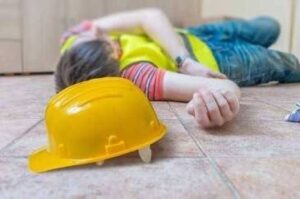Safety is a top priority on any construction site, and one of the most common hazards faced by workers is the risk of falling objects. In Stafford County, Kansas, construction sites adhere to specific requirements to ensure the safety and well-being of workers and visitors. This article aims to provide essential guidelines on how to protect yourself from falling objects on construction sites in Stafford County. By following these precautions and being aware of the regulations, you can greatly reduce the risk of accidents and injuries. Remember, prevention is key, and everyone has a role to play in maintaining a safe construction environment.
Understanding the Requirements
To maintain a safe working environment, construction sites in Stafford County, Kansas must comply with various regulations regarding falling object protection. These requirements are in place to safeguard the workers, as well as anyone who may be visiting the site. Here are some key regulations that you should be aware of:
Personal Protective Equipment (PPE): The use of proper personal protective equipment is crucial. Hard hats should be worn at all times on the construction site. Ensure that your hard hat fits correctly and is in good condition, with no cracks or damage.
Secure Tool Storage: Tools and equipment should be stored properly when not in use. Ensure that tools are placed in designated areas or secured with tethers to prevent them from falling and causing harm to workers below.
Barricades and Warning Signs: Construction sites must have clear barricades and warning signs to alert workers and visitors about potential falling hazards. These signs should be visible and easily understood by everyone on-site.
Regular Inspection: Regular inspection of the construction site is essential to identify potential hazards. Supervisors and safety officers should conduct thorough inspections to ensure that materials, equipment, and scaffolding are secure and in proper condition.
Preventing Falling Objects
Preventing falling objects requires a proactive approach and constant vigilance. Here are some important measures to help protect yourself and others on a construction site:
Secure and Properly Store Tools: Always secure your tools and equipment when not in use. Use tool lanyards or retractable tethers to prevent tools from falling. Additionally, store tools and equipment in designated areas or toolboxes to minimize the risk of accidental drops.
Secure Scaffolding and Platforms: Scaffolding and elevated work platforms should be secure and stable. Ensure that guardrails are properly installed and that workers are trained in their use. Regular inspections of scaffolding should be conducted to identify any structural issues or potential hazards.
Use Safety Nets and Toe Boards: Safety nets and toe boards provide an added layer of protection against falling objects. Safety nets should be installed where there is a risk of objects falling from heights. Toe boards, on the other hand, are placed at the edge of elevated work surfaces to prevent tools or materials from sliding off.
Regular Tool Inspections: Regularly inspect your tools and equipment for any signs of wear and tear. Ensure that handles, grips, and attachments are secure. Replace damaged or faulty tools immediately to avoid accidents.
Communication and Awareness: Effective communication is essential on a construction site. Always inform your colleagues when working at heights or performing tasks that involve potential falling hazards. Being aware of your surroundings and the activities of others can help prevent accidents.
Follow Proper Lifting Techniques: When lifting heavy objects, use proper lifting techniques to minimize the risk of dropping them. Bend your knees, keep your back straight, and lift with your legs rather than your back. If an object is too heavy or awkward to lift safely, seek assistance or use lifting equipment.
Secure Materials and Debris: Loose materials and debris can pose a significant hazard if they fall from elevated surfaces. Ensure that materials, such as bricks, lumber, or tools, are properly secured or stored on sturdy shelves or racks. Implement regular cleanup routines to keep the construction site free from clutter and potential tripping hazards.
Stay Clear of Hazard Zones: Be aware of designated hazard zones on the construction site. These areas are typically marked with caution tape or signage and indicate areas where falling objects are more likely to occur. Avoid entering these zones unless necessary and follow any instructions or restrictions provided.
Regular Safety Training and Toolbox Talks: Stay updated with safety training programs and toolbox talks provided by your employer. These sessions often cover important safety protocols and emphasize the significance of falling object prevention. Take an active role in attending these training sessions and encourage open communication among your fellow workers regarding safety concerns.
Report Unsafe Conditions: If you notice any unsafe conditions or potential hazards related to falling objects, report them immediately to your supervisor or the appropriate authority. Prompt reporting can help address the issue and prevent accidents before they occur.
Protecting yourself from falling objects on a construction site is crucial for your safety and the safety of others. By adhering to the regulations set forth by Stafford County, Kansas, and following the preventive measures outlined in this article, you can greatly reduce the risk of accidents and injuries. Remember to wear your personal protective equipment, secure tools and equipment, and communicate effectively with your colleagues.
If you have any questions or concerns about falling object protection or any other construction site safety measures, don’t hesitate to reach out to Melinda Young Law Firm. Our experienced attorneys can provide guidance and legal assistance to help you navigate any construction-related issues. Stay safe and make safety a priority on every construction site.
